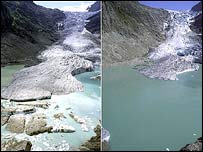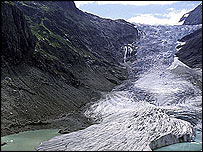
Some glaciers in Europe have suffered significant losses
|
Average glacial shrinkage has risen from 30 centimetres per year between 1980 and 1999, to 1.5 metres in 2006.
Some of the biggest losses have occurred in the Alps and Pyrenees mountain ranges in Europe.
Experts have called for "immediate action" to reverse the trend, which is seen as a key climate change indicator.
Estimates for 2006 indicate shrinkage of 1.4 metres of 'water equivalent' compared to half a metre in 2005.
Achim Steiner, Under-Secretary General of the UN and executive director of its environment programme (UNEP), said: "Millions if not billions of people depend directly or indirectly on these natural water storage facilities for drinking water, agriculture, industry and power generation during key parts of the year.
"There are many canaries emerging in the climate change coal mine. The glaciers are perhaps among those making the most noise and it is absolutely essential that everyone sits up and takes notice.
Litmus test
He said that action was already being taken and pointed out that the elements of a green economy were emerging from the more the money invested in renewable energies.
Mr Steiner went on: "The litmus test will come in late 2009 at the climate convention meeting in Copenhagen.
"Here governments must agree on a decisive new emissions reduction and adaptation-focused regime. Otherwise, and like the glaciers, our room for manoeuvre and the opportunity to act may simply melt away."
Dr Ian Willis, of the Scott Polar Research Institute, said: "It is not too late to stop the shrinkage of these ice sheets but we need to take action immediately."
The findings were compiled by the World Glacier Monitoring Service which is supported by UNEP. Thickening and thinning is calculated in terms of 'water equivalent'.
Glaciers across nine mountain ranges were analysed.

Glaciers have been monitored for more than a century
|
Dr. Wilfried Haeberli, director of the service, said: "The latest figures are part of what appears to be an accelerating trend with no apparent end in sight.
"This continues the trend in accelerated ice loss during the past two and a half decades and brings the total loss since 1980 to more than 10.5 metres of water equivalent."
During 1980-1999, average loss rates had been 0.3 metres per year. Since the turn of the millennium, this rate had increased to about half a metre per year.
The record annual loss during these two decades - 0.7 metres in 1998 - has now been exceeded by three out of the past six year (2003, 2004 and 2006).
On average, one metre water equivalent corresponds to 1.1 metres in ice thickness. That suggests a further shrinking in 2006 of 1.5 actual metres and since 1980 a total reduction in thickness of ice of just over 11.5 metres or almost 38 feet.
In its entirety, the research includes figures from around 100 glaciers, with data showing significant shrinkage taking place in European countries including Austria, Norway, Sweden, Italy, Spain and Switzerland.
Norway's Breidalblikkbrea glacier thinned by almost 3.1 metres in one of the largest reductions.
